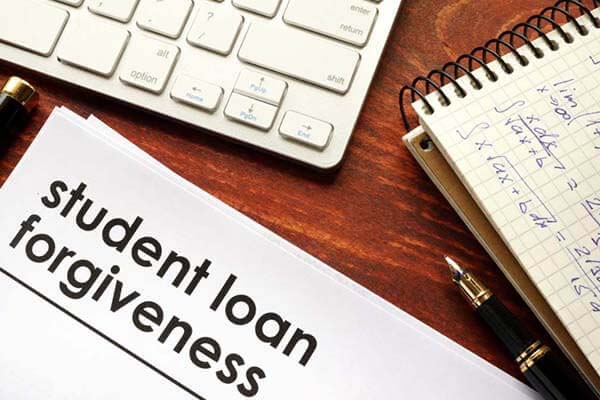Guide to Student Loan Forgiveness
In 2020, student loan debt hit a record-breaking $1.56 trillion nationwide. Even before the COVID-19 pandemic, millions of Americans found themselves straddled with anxiety-inducing debt loads they weren’t sure they’d ever pay off.
The good news is: You may qualify for some relief. While there’s no shortcut for dealing with student loans, there are many student loan forgiveness programs that can significantly decrease how much you wind up paying overall.
Your student loan forgiveness options can depend on the type of loan you have, where you live, where you work, and how much you earn. And while each program comes with its own set of (sometimes tricky to navigate) rules, the wide variety opens up options you may not have thought you had. Here’s what you need to know:
Federal Student Loan Forgiveness Programs
You’ll have the most options if you have federal student loans. That’s because private student loans aren’t eligible for the federal loan repayment assistance programs and some programs only help repay federal student loan debt.
However, even if you have federal loans, you’ll need to meet the eligibility requirements. For example, two popular federal forgiveness programs require you to repay your federal loans with certain repayment plans or work at an eligible employer while making your payments.
- Income-Driven Repayment Plan Forgiveness: Income-driven repayment (IDR) plans can lower your monthly payment by basing your payment on your income and family size. Additionally, IDR has a limited repayment period. Depending on the plan, the remainder of your student loan will be forgiven after you make payments for 20 to 25 years.
- Public Service Loan Forgiveness: The Public Service Loan Forgiveness (PSLF) program is one of the most popular forgiveness programs because you can get the remainder of your federal loans forgiven after making 120 monthly payments (10 years’ worth). However, you need to have Direct student loans (a type of federal loan), be on a qualifying repayment plan, and work full-time for a qualified nonprofit or government organization while making those payments.
There are additional federal loan forgiveness or cancellation programs as well, including the Teacher Loan Forgiveness and Perkins Loan Cancellation and Discharge programs. And, you might qualify to have your loan discharged (i.e., you won’t owe the money) in other special circumstances, such as if you become totally and permanently disabled.
State-Dependent Loan Forgiveness Programs
Some states and state-based organizations also have student loan forgiveness programs for eligible residents. These tend to be for people who work in a particular profession, such as healthcare workers and attorneys, and who serve a high-need population within the state.
Profession-Dependent Student Loan Forgiveness Programs
In addition to the state-dependent programs, there are federal-, school-, and industry-funded loan repayment assistance programs (LRAPs) available to members of certain professions. Generally, you’ll need to commit to working in a specific job or area for several years to receive the assistance.
Similar to the state-dependent programs, these also tend to be for healthcare workers and lawyers working in underserved areas. But you may be able to find opportunities in other fields as well.
Student Loan Forgiveness Programs for Military Members
Service members may be eligible for the PSLF. Additionally, there are student loan repayment assistance programs for service members with different amounts of assistance depending on the branch, current need, and your experience.
Employers’ Student Loan Forgiveness Programs
Some companies offer student loan forgiveness as a benefit to employees. These aren’t wide-spread benefits, but they’re worth asking about while job hunting. Sometimes, the company will make regular payments to your loan servicer on your behalf. Or, the company may offer to match part of your monthly loan payment.
COVID-19 and Student Loan Relief
The Coronavirus Aid, Relief, and Economic Security (CARES) Act didn’t directly offer student loan forgiveness to borrowers, but it did provide temporary relief to borrowers with federally held student loans.
Eligible loans receive a 0% interest rate and deferred payments from March 13 through September 30, 2020. Additionally, the missed payments count as qualifying payments toward IDR forgiveness. They also count toward your required 120 PSLF payments if you meet the other requirements, including remaining a full-time employee at a qualifying organization.
Private student loan companies may also offer hardship programs to borrowers, although the CARES Act doesn’t require it and the loans won’t be eligible for federal forgiveness programs.
Learn More and Confirm You’re On The Right Track
While student loan forgiveness programs can save you a lot of money, the rules and requirements can be complicated to understand and follow. Unfortunately, some student loan servicers (the companies you send your payments to) don’t have a great track record of helping steer borrowers in the right direction.
The Department of Education is a good place to start if you want to learn more about the federal student loan forgiveness options.
If you have specific questions, you can also find low-cost student loan counselors at nonprofit credit counseling organizations. Or, student loan attorneys who can help you with more complex questions and help if you’ve been wronged.
Quicken has made the material on this blog available for informational purposes only. Use of this website constitutes agreement to our Terms of Use and Privacy Policy. Quicken does not offer advisory or brokerage services, does not recommend the purchase or sale of any particular securities or other investments, and does not offer tax advice. For any such advice, please consult a professional.



